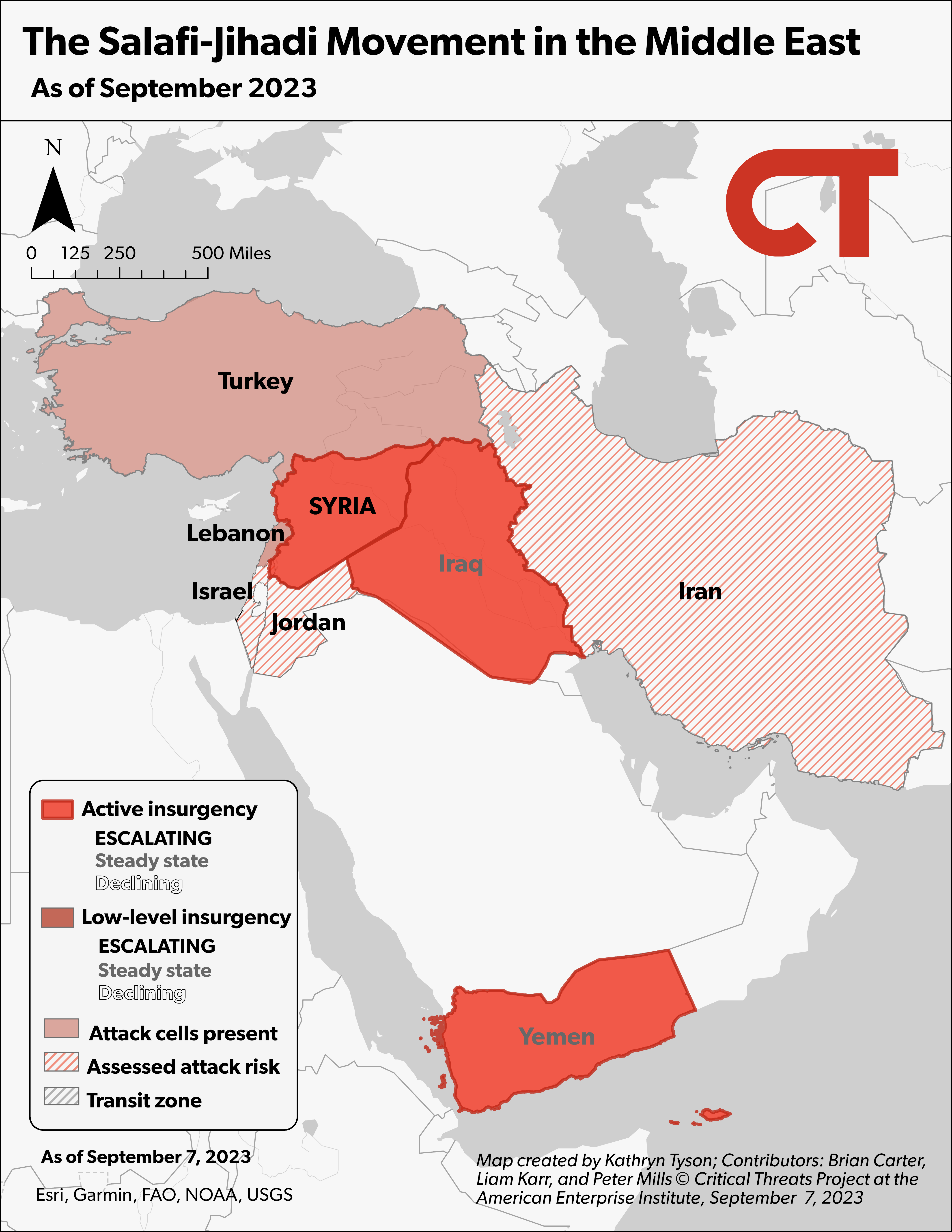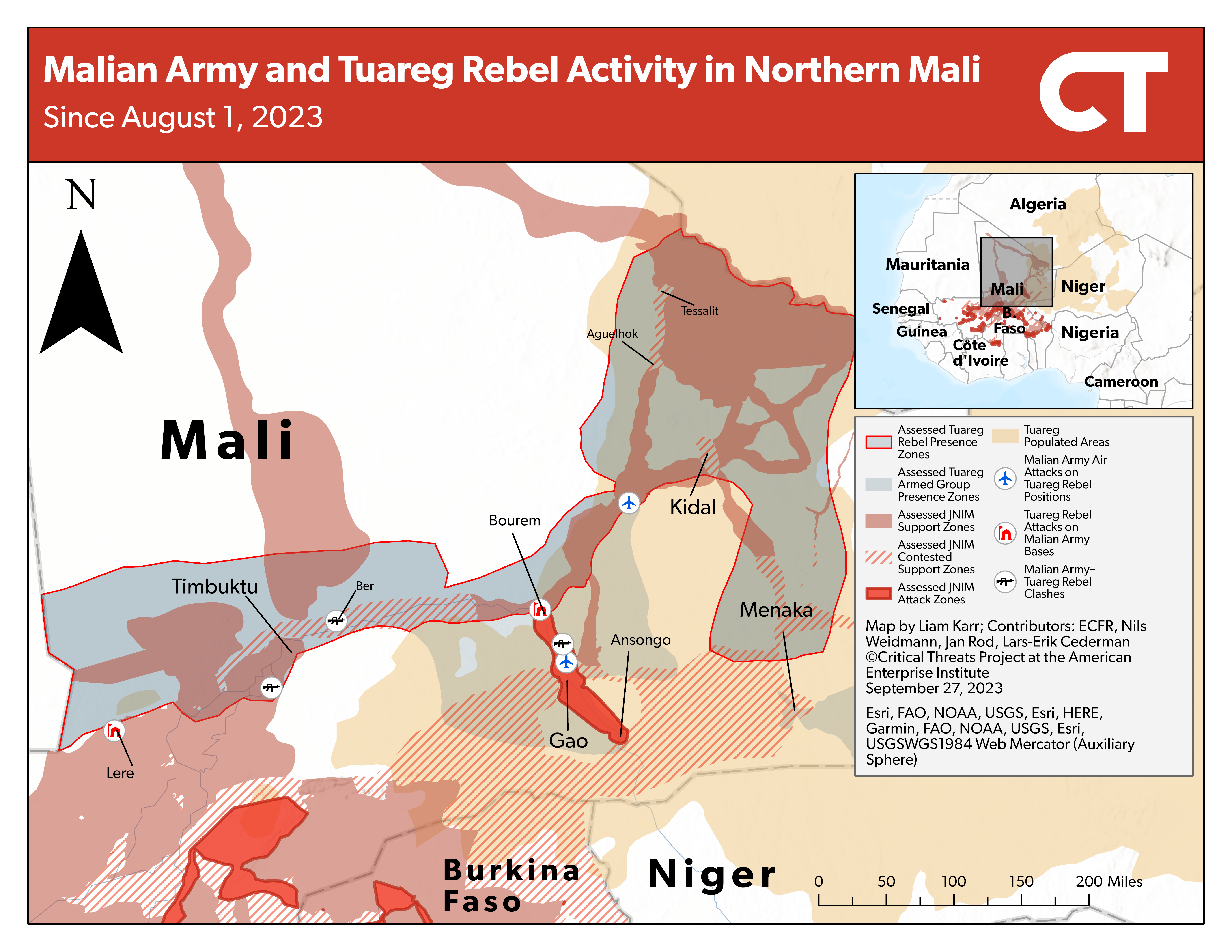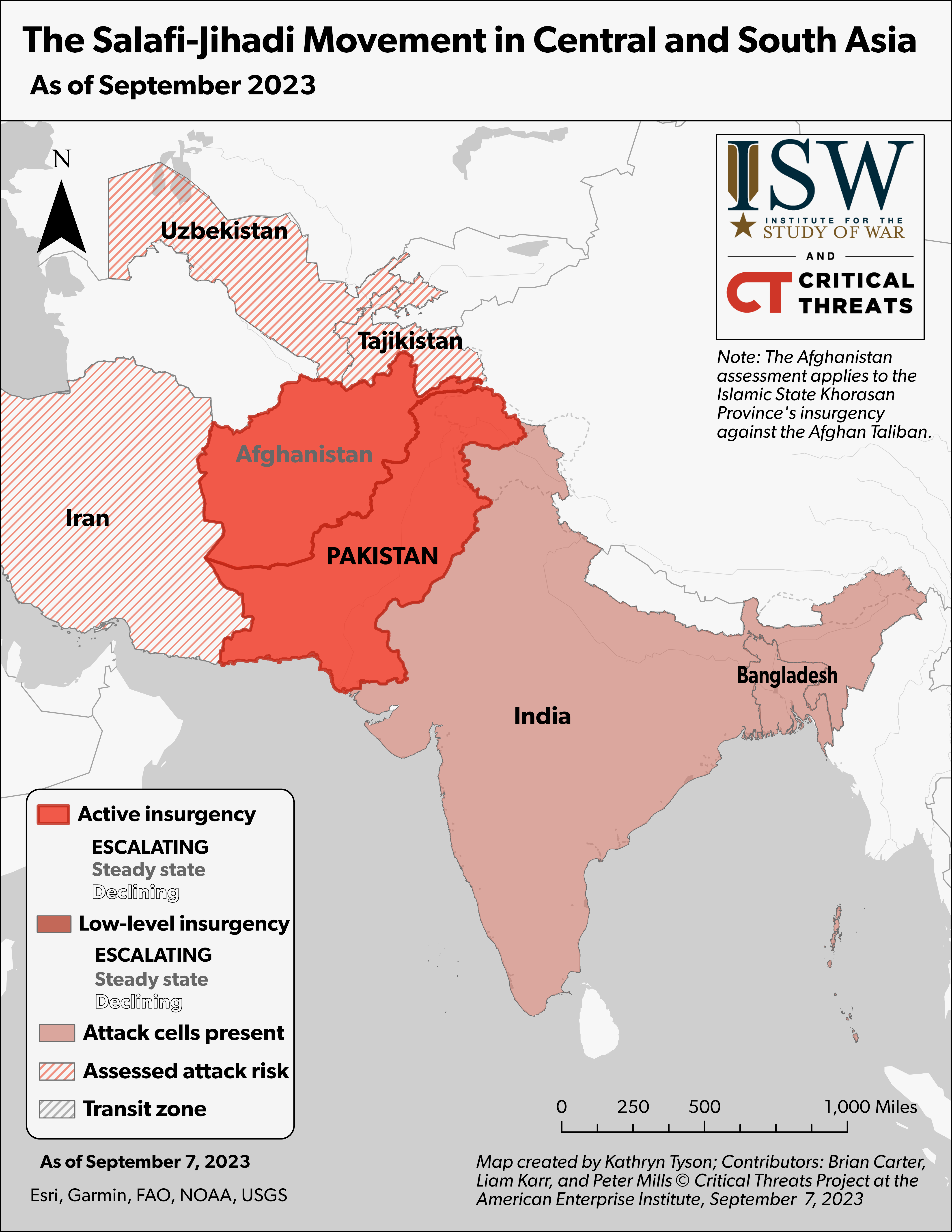Salafi-Jihadi Movement Update, September 27: Tribal Insurgency May Expand in Syria; Mali and Separatist Rebels Resume Fighting; Afghan Taliban and Pakistan Discuss Cross-Border Attacks; Iran Targets IS-Affiliated Militants in Iran
Authors: Brian Carter, Liam Karr, Kathryn Tyson, Peter Mills
Data Cutoff: September 27, 2023, at 10 a.m.
Key Takeaways:
Iraq and Syria. The Syrian Democratic Forces (SDF) attacks against civilians in eastern Syria are contributing to popular grievances and may cause the tribal insurgency to expand geographically. CTP is tracking several indicators that would suggest either a contraction or expansion of the tribal insurgency in northeastern Syria.
Mali. The resumption of fighting between the Malian government and non-jihadist Tuareg rebels will likely enable al Qaeda–linked militants to further ingratiate themselves with communities in northern Mali, potentially establishing de facto control and shadow governance in some nominally rebel-controlled areas. Growing control in northern Mali will enable al Qaeda–linked militants to pose a greater transnational threat.
Pakistan. Afghan Taliban and Pakistani officials met in Kabul on September 21 to resolve hostilities over border-security issues, including cross-border Tehrik-e Taliban Pakistan (TTP) attacks. The Taliban refused to publicly mention measures against the TTP, which suggests it will not stop the group from conducting attacks in Pakistan.
Afghanistan. Iran claimed it conducted raids targeting IS-affiliated militants in West Azerbaijan Province who Iran alleged were planning coordinated bomb attacks in Tehran, Iran. Iranian state media suggested these militants were connected to Islamic State Khorasan Province (ISKP) and ISIS.
Assessments:
Iraq and Syria
Author: Brian Carter
The SDF’s attacks against civilians in eastern Syria are contributing to popular grievances and may cause the tribal insurgency to expand geographically. Tribal insurgent leader Ibrahim al Hifl called for tribal forces to rise up again against the SDF on September 25, which coincided with the capture of Dhiban and Tayyana by tribal fighters the same day.[1] SDF fighters manning checkpoints in the town retreated from both towns, and the SDF dispatched reinforcements from elsewhere in Deir ez Zor.[2] The SDF’s response, which featured indiscriminate shelling and the deployment of major reinforcements for an assault against the tribes, is contributing to the popular grievances that spurred the initial fighting.[3] The SDF is also arresting large numbers of locals.[4] SDF abuse of civilians and shelling and firing indiscriminately into civilian areas was one of the reasons the fighting spread beyond heavily pro–Deir ez Zor Military Council areas in early September.[5] The SDF is also blaming the regime for the attacks, which indicates that the SDF will not address the grievances because it sees the attacks as a regime conspiracy to destroy the SDF and not a violent rejection of the SDF caused by legitimate grievances.[6]
- Tribal insurgent leader and Akidat Sheikh Hifl called for tribal fighters to launch an attack against the SDF on September 25, which led to the capture of Dhiban and Tayyana the same day.[7] Tribal forces forced SDF withdrawals from both Dhiban and Tayyana toward the Deir ez Zor desert and Green Village area on September 25.[8] Hifl is attempting to broaden his support base by appealing for support from “the people of the Euphrates” and calling for the return of Arab heritage to Deir ez Zor.[9] Some Shuhayt tribesmen conducted attacks against SDF positions in Abu Hammam, but the Bakkara tribe in northern Deir ez Zor have so far not responded to Hifl’s call.[10]
- The SDF is continuing to ignore the grievances that drove the insurgency, and it is poised for a major assault against the two towns. The SDF claimed on September 25 that regime forces “infiltrated” Dhiban and “randomly shelled” the town.[11] Local Arab sources disputed this statement, alleging that the SDF randomly shelled the town of Dhiban, causing civilian casualties.[12] The SDF also said on September 18 that its retribution would come at a “place and time” of the SDF’s choosing.[13] This does not support the SDF’s general amnesty issued on September 7.[14] These responses indicate that the SDF views the revolt not as a response to legitimate grievances, but instead a conspiracy to destroy the SDF. This suggests the SDF is less willing to compromise.
CTP is tracking the following indicators that would suggest the tribal insurgency will expand geographically, in rate of attack, or adopt more deadly attack types:
Figure 1. Indicators Suggesting the Expansion of the Anti-SDF Insurgency in Deir ez Zor, Syria
Source: Author’s research.
CTP is tracking indicators that would suggest the tribal insurgency will contract geographically or in rate of attack:
Figure 2. Indicators Suggesting the Contraction of the Anti-SDF Insurgency in Deir ez Zor, Syria
Source: Author’s research.
Figure 3. The Salafi-Jihadi Movement in the Middle East
Source: Kathryn Tyson.
Mali
Author: Liam Karr
The Malian government and non-jihadist Tuareg rebels resumed fighting for the first time since 2015, which will likely enable al Qaeda–linked militants to further ingratiate themselves with communities in northern Mali by supporting the rebels. Rebel groups and the Malian army have clashed at least eight times since the beginning of August.[15] The fighting and the pro-separatist rebels’ effective declaration of war on September 11 destroys the contentious and largely unimplemented 2015 peace agreement between the two sides.[16] Al Qaeda’s Sahelian affiliate Jama’at Nusrat al Islam wa al Muslimeen (JNIM) has already been working with the rebel groups and their communities against the Islamic State Sahel Province (ISSP) since at least 2021, and the leaders of the two factions have relationships dating to the 1990s.[17] JNIM and the rebels also have a shared objective of expelling Malian forces. UN experts noted that the rebel groups have been hesitant to publicly ally with JNIM against ISSP despite working with JNIM, and rebel leaders have publicly denied any current or future engagement with JNIM.[18] Allying with the al Qaeda–linked militants also backfired on the rebels in the 2012 rebellion.[19] However, the pattern of loose collaboration in recent years, the shared goal of removing Malian forces, and the overlapping human networks will facilitate continued tacit cooperation, at least, between the two sides.
- The Malian government and Tuareg rebels signed the Algiers peace agreement in 2015. The agreement included provisions on decentralized government and the disarmament, demobilization, and reintegration of ex-rebels that went largely unimplemented.[20] Rebel leaders increasingly warned that the deal was falling apart throughout 2022 and said the decision to end the UN mission in June was a “fatal blow” to the agreement.[21]
- JNIM is positioning itself as a security partner for rebel groups and their local communities against ISSP after ISSP expanded north from the Nigerien border into Tuareg-populated areas of northeastern Mali following the French withdrawal in 2021.[22] This has included military cooperation and meetings between JNIM Emir Iyad ag Ghali and rebel leaders to discuss a formal anti-ISSP alliance.[23] UN experts noted in an August report that JNIM’s outreach has led community leaders in rebel-controlled areas to provide support—including combatants—to JNIM to help fight ISSP, with some militants belonging to both JNIM and a rebel group.[24]
- Iyad ag Ghali and other al Qaeda–linked militants now in JNIM initially fought alongside the rebel groups during the 2012 Tuareg rebellion.[25] The al Qaeda–linked faction sidelined the rebels in 2013 and asserted uncontested control over previously jointly held areas.[26] This prompted the French-led intervention in 2013, which helped split the remaining non-jihadist rebels from ag Ghali’s group and ultimately forced them into the contentious 2015 peace agreement.[27] However, ag Ghali’s connections with many of the rebel leaders stretch back decades before the 2012 rebellion and have remained intact since.[28]
JNIM will likely leverage its local legitimacy and ties to rebel groups to peacefully co-opt leadership in northern towns, which would result in de facto JNIM control and shadow governance over nominally rebel-controlled areas. JNIM has already cultivated nonaggression deals with many of the Tuareg groups, which has safeguarded both groups’ support zones for the past several years.[29] UN experts noted that JNIM has also established itself as the leading authority in many areas of northern Mali, making rebel groups reliant on JNIM for their own legitimacy.[30] Al Qaeda’s regional leadership internally admitted that forcefully sidelining pro-separatist groups and enforcing harsh brands of shari’a in 2012 was a mistake that alienated local communities.[31] This organizational learning suggests they will pursue some compromise with locally attuned shadow governance instead of forcibly dominating rebel groups. Pro-separatist rebels have already self-imposed some aspects of shari’a in areas they administer, which suggests these rebels will be more receptive to some JNIM demands.[32]
- The UN experts’ August report on Mali said that some officers of rebel groups believe that being portrayed with JNIM gives them credibility in their communities.[33] This phenomenon is partially because of JNIM’s efforts to build local legitimacy by framing itself as a local protector from ISSP.[34]
JNIM control in northern Mali will enable the group to pose a greater transnational threat, and the group could use its inroads with Tuareg groups to leverage human networks in other countries. Al Qaeda–linked militants in JNIM have carried out regional terror attacks and still aspire to build external attack capabilities targeting the West, despite giving priority to their locally focused insurgency in recent years.[35] JNIM’s growing support zones in northern Mali will give it access to the space, resources, and recruitment pools needed to stage regional and international terror attacks.
JNIM’s ties with Malian Tuareg groups also provide it an opportunity to build its relationships with the transnational Tuareg population. These relationships would allow JNIM to further increase its presence in regional human and smuggling networks to move attack cells from West Africa toward North Africa and Europe, if it chooses to give priority to external operations.[36] Some JNIM leaders have threatened to attack Europe and the US, which indicates some factions would support transnational plots even if most group leadership does not give priority to rebuilding external attack capabilities.[37]
Figure 4. Malian Army and Tuareg Rebel Activity in Northern Mali
Source: Liam Karr.
Figure 5. The Salafi-Jihadi Movement in Africa
Source: Kathryn Tyson.
Pakistan
Author: Kathryn Tyson
Afghan Taliban and Pakistani officials met in Kabul on September 21 to resolve hostilities over border-security issues, including cross-border TTP attacks. The Taliban refused to publicly mention measures against the TTP, which suggests it will not stop the TTP from conducting attacks in Pakistan. The meeting aimed to resolve hostilities stemming from coordinated TTP attacks from Afghanistan into Pakistan, border clashes between Pakistani and Taliban security forces, and the closure of a major border crossing. Unspecified officials said the Taliban agreed on a “concrete plan” to neutralize the TTP in Afghanistan during the talks.[38] However, the Taliban did not publicly mention any discussions on the TTP after the meetings.[39] This discrepancy suggests the Taliban will not uphold measures to counter the TTP in Afghanistan. The Taliban also did not implement previous plans in 2023 to disrupt TTP cross-border operations into Pakistan. CTP cannot discount the possibility that this discrepancy indicates the Taliban will take steps against the TTP that it will not publicly acknowledge. Unspecified Pakistani sources reported that the Taliban captured and imprisoned TTP members involved in a series of cross-border attacks in early September, but the Taliban has not confirmed this.[40]
- The Taliban and Pakistan held talks to ease political tensions after a TTP attack and Afghanistan-Pakistan border conflict in early September. Hundreds of TTP militants launched a series of cross-border attacks from eastern Afghanistan into Chitral, northwestern Pakistan, from September 9 to September 11.[41] Pakistani and Taliban security forces clashed at the key border crossing of Torkham on September 6, closing the crossing until September 15.[42] The Taliban and Pakistan have traded blame over similar cross-border attacks and border clashes in 2023 and later held meetings to reduce tensions.[43]
- The Taliban is publicly downplaying discussions about the TTP, highlighting the Taliban’s hesitance about implementing measures to disrupt TTP operations. The Taliban's foreign ministry released a statement on the talks but did not specifically mention the TTP or any plans to curb the group.[44] Unspecified diplomats and officials reported that the Taliban had agreed to specific plans to hinder TTP activities inside Afghanistan.[45] Pakistan’s director of military operations was in the meeting, suggesting the military and terrorism issues were discussed.[46]
- The Taliban has promised concrete plans to curb TTP attacks in 2023 but has not acted on these plans. The Taliban government said it would relocate TTP militants away from Afghanistan’s eastern border to its northern in June 2023, but it has not fulfilled this commitment.[47] The TTP issued a letter that rejected reports that the Taliban relocated TTP fighters within Afghanistan.[48] The TTP also instructed its commanders to resist efforts to relocate them.[49] The Taliban has restrained TTP attacks in the past to quell political and military tensions between Afghanistan and Pakistan, but there is no indication it is currently doing this. Weekly TTP attack numbers have continued at the same week-over-week rate during September.
The number of TTP attacks will decrease in the coming months due to the end of the fighting season, which the Taliban may use to claim that Taliban security forces stopped the TTP’s operations from Afghanistan. Severe winter weather conditions will impede or close routes used by TTP fighters to cross between Afghanistan and Pakistan to attack. The winter months have also traditionally prompted a lull in fighting, which the TTP used to rest and regroup its forces to prepare for a spring offensive. A decreased attack rate enables the Taliban to message a lower TTP threat from Afghanistan, which would support the Taliban’s claim that Afghanistan is not a safe haven for the TTP.
- Snowfall and hazardous weather conditions often close major highways, border crossings, and mountain passes between Afghanistan and Pakistan for several months during the winter.[50] These conditions will limit the ability of the TTP to move forces between Afghanistan and Pakistan to attack, therefore decreasing the rate of attacks. The TTP has also used the winter months to prioritize growing its fighting force to prepare for a spring offensive.[51]
- The Taliban has repeatedly denied Islamabad’s accusations that the TTP uses Afghanistan as a safe haven to conduct attacks into Pakistan.[52] The Taliban also is unwilling and unable to destroy these havens and actively supports cross-border attacks. Taliban border forces do not receive adequate training or funding to hinder TTP attacks in Pakistan.[53] Taliban foot soldiers have participated in TTP attacks in Pakistan in 2023.[54] The Taliban shares close ideological ties with the TTP and considers it a part of the emirate rather than a threat, which limits its willingness to counter the TTP.[55]
Afghanistan
Author: Peter Mills
Iran claimed it conducted raids targeting IS-affiliated militants in West Azerbaijan Province who Iran alleged were planning coordinated bomb attacks in Tehran.[56] Iranian state media claimed these militants were connected to IS branches in Afghanistan, northern Iraq, Pakistan, and Syria, which refers to ISKP and ISIS.[57] ISKP routinely threatens to conduct attacks in Iran and claimed an attack in Shiraz in October 2022.[58] Iranian regime media released videos showing captured suicide vests (SVEST), which supports the regime's claim that these militants are connected to IS.[59] IS frequently uses SVESTs, and IS-linked fighters used SVESTs during an attack on Iran’s parliament in 2017.[60] Iranian regime reporting linking these militants to the Iraqi Kurdistan region is consistent with Iran’s stated security concerns from Kurdish Iranian opposition groups, which Iran refers to as terrorist organizations.[61] Iran has used these security concerns to pressure Iraqi authorities into cracking down on these opposition groups.
- Iranian leadership has repeatedly accused Kurdish Iranian opposition groups in the Iraqi Kurdistan Region of arming and fueling domestic discontent, including those who participated in the Masha Amini protest movement in 2022.[62] Iraqi Security Forces and Kurdish Peshmerga removed Kurdish Iranian opposition groups from the Iran-Iraq Kurdistan border to address Iranian security demands under a joint Iraq-Iran security agreement.[63]
Figure 7. The Salafi-Jihadi Movement in Central and South Asia
Source: Kathryn Tyson.
[1] https://eyeofeuphrates dot com/ar/news/2023/09/25/9760; https://x.com/DeirEzzore/status/1706268360869097978?s=20; https://x.com/DeirEzzore/status/1706255573237264406?s=20
[3] https://x.com/DeirEzzorNow/status/1706372805200109651?s=20; https://x.com/DeirEzzorNow/status/1706372801148436580?s=20; https://twitter.com/DeirEzzorNow/status/1706234368002339112
[5] https://shaam dot org/reports/battleground-reports/hsad-alahdath-almydanyh-lywm-alarbaaa-06-09-2023; https://twitter.com/DeirEzzore/status/1697893012250964341; https://newlinesmag.com/argument/assads-hidden-hand-in-the-uprising-against-the-kurds-in-eastern-syria
[6] https://twitter.com/farhad_shami/status/1706322130449645692; https://npasyria dot com/en/105178
[7] https://eyeofeuphrates dot com/ar/news/2023/09/25/9760; https://x.com/DeirEzzore/status/1706268360869097978?s=20; https://x.com/DeirEzzore/status/1706255573237264406?s=20
[9] https://eyeofeuphrates dot com/ar/news/2023/09/25/9760
[12] https://x.com/DeirEzzorNow/status/1706372801148436580?s=20; https://x.com/alsharqia24news/status/1706238580991864993?s=20
[14] https://www.reuters.com/world/middle-east/kurdish-led-syria-force-vows-meet-tribal-demands-after-clash-2023-09-07
[15] Author’s database of significant activity.
[16] https://www.lemonde.fr/en/le-monde-africa/article/2023/09/12/mali-former-rebel-group-claims-they-are-in-time-of-war-with-ruling-junta_6133155_124.html; https://www.csis.org/analysis/why-mali-needs-new-peace-deal
[17] https://digitallibrary.un.org/record/4019115; https://jamestown.org/program/anarchy-azawad-guide-non-state-armed-groups-northern-mali
[18] https://www.rfi.fr/fr/podcasts/invit%C3%A9-afrique/20230928-mali-attaye-ag-mohamed-notre-action-au-csp-est-plac%C3%A9e-dans-le-cadre-de-la-l%C3%A9gitime-d%C3%A9fense
[21] https://www.lemonde.fr/afrique/article/2022/07/18/au-mali-l-ex-rebellion-touareg-deplore-l-abandon-de-l-accord-de-paix-par-les-autorites-de-transition_6135178_3212.html; https://www.lemonde.fr/afrique/article/2022/12/10/au-mali-l-ex-rebellion-touareg-appelle-a-eviter-une-rupture-definitive-de-l-accord-de-paix_6153768_3212.html; https://www.reuters.com/world/africa/mali-rebels-warn-un-peacekeeping-departure-will-kill-peace-deal-2023-06-22
[22] https://www.hrw.org/news/2022/10/27/mali-coordinated-massacres-islamist-armed-groups; https://digitallibrary.un.org/record/4019115; https://www.criticalthreats.org/briefs/africa-file/africa-file-al-qaeda-linked-militants-take-control-in-northern-mali
[23] https://x.com/SimNasr/status/1547626334817423360?s=20; https://www.rfi.fr/fr/afrique/20230130-mali-iyad-ag-ghaly-rencontre-les-groupes-signataires-de-l-accord-de-paix-pr%C3%A8s-de-kidal
[28] Alexander Thurston, Jihadists of North Africa and the Sahel: Local Politics and Rebel Groups (Cambridge, UK: Cambridge University Press, 2020), 107, 110, 114, 118, and 130; https://www.militantwire.com/p/jnim-emir-exploits-anti-islamic-state
29 https://www.crisisgroup.org/africa/sahel/mali/laccord-dalger-cinq-ans-ap...
30 https://digitallibrary.un.org/record/4019115
31 https://ctc.westpoint.edu/aqims-playbook-in-mali; https://ctc.westpoint.edu/the-local-face-of-jihadism-in-northern-mali
32 https://sahelblog.wordpress.com/2019/02/20/mali-sharia-in-kidal
[35] https://www.aei.org/research-products/report/the-underestimated-insurgency-continued-salafi-jihadi-capabilities-and-opportunities-in-africa; https://www.aei.org/research-products/report/terrorism-tactics-and-transformation-the-west-vs-the-salafi-jihadi-movement
[36] https://ctc.westpoint.edu/wp-content/uploads/2022/04/AQIMs-Imperial-Playbook.pdf; https://africacenter.org/publication/puzzle-jnim-militant-islamist-groups-sahel; https://globalinitiative.net/analysis/jnim-burkina-faso; https://www.airuniversity.af.edu/JIPA/Display/Article/2425320/lassoing-the-haboob-countering-jamaat-nasr-al-islam-wal-muslimin-in-mali-part-i; https://www.unodc.org/documents/data-and-analysis/tocta_sahel/TOCTA_Sahel_som_2023.pdf
[37] https://africanperceptions dot org/ar/2023/03/%d8%b9%d8%ab%d9%85%d8%a7%d9%86-%d8%a7%d9%84%d9%82%d9%8a%d8%b1%d9%88%d8%a7%d9%86%d9%8a-%d9%84%d8%a7%d9%84%d8%b1%d8%a4%d9%89-%d8%a7%d9%84%d8%a7%d9%81%d8%b1%d9%8a%d9%82%d9%8a%d8%a9-%d8%b3%d9%86; SITE Intelligence Group, “Africa-Focused News Blog Interviews JNIM Official on Group’s Mission and Growing Circle of Operations, Attacks in Benin and Togo,” March 24, 2023, available by subscription at www.siteintelgroup.com; https://www.sinosecurity.org/p/al-qaeda-media-jnims-leader-celebrates
[38] https://www.voanews.com/a/taliban-pledge-to-neutralize-activities-of-afghan-based-pakistani-militants/7279359.html?utm_source=iterable&utm_medium=email&utm_campaign=7784821_; https://twitter.com/khorasandiary/status/1704935778789277834; https://twitter.com/HafizZiaAhmad1/status/1704857903407198543
[39] https://www.voanews.com/a/taliban-pledge-to-neutralize-activities-of-afghan-based-pakistani-militants/7279359.html?utm_source=iterable&utm_medium=email&utm_campaign=7784821_; https://twitter.com/khorasandiary/status/1704935778789277834; https://twitter.com/HafizZiaAhmad1/status/1704857903407198543
[40] https://twitter.com/TajudenSoroush/status/1707367768180379937; https://twitter.com/AFIntlBrk/status/1707119314258612402
[41] https://www.rferl.org/a/pakistani-taliban-land-grab-insurgency-islamabad/32595679.html; https://www.thedefensepost.com/2023/09/07/troops-clash-pakistan-taliban
[42] https://www.reuters.com/world/asia-pacific/main-afghanistan-pakistan-border-crossing-reopens-after-nine-day-closure-source-2023-09-15
[43] https://www.rferl.org/a/afghanistan-pakistan-torkham-border-clashes/32279010.html; https://www.reuters.com/world/asia-pacific/pakistan-army-concerned-over-afghan-militant-safe-havens-threatens-response-2023-07-14; https://apnews.com/article/pakistan-afghan-taliban-trade-security-cooperation-aaf2b89a22164c42825e21d82e1cc98e
[45] https://twitter.com/khorasandiary/status/1704935778789277834; http://tolonews dot com/afghanistan-185214; https://www.voanews.com/a/taliban-pledge-to-neutralize-activities-of-afghan-based-pakistani-militants/7279359.html?utm_source=iterable&utm_medium=email&utm_campaign=7784821_; https://www.voanews.com/a/taliban-pledge-to-neutralize-activities-of-afghan-based-pakistani-militants/7279359.html
[47] https://www.criticalthreats.org/analysis/salafi-jihadi-movement-weekly-update-june-21-2023#AFG20230621; https://www.criticalthreats.org/analysis/salafi-jihadi-movement-weekly-update-june-28-2023#AFG20230630
[48] https://twitter.com/Natsecjeff/status/1671967534755766277; https://twitter.com/ShabbirTuri/status/1671966123586363392
[49] https://twitter.com/Natsecjeff/status/1671967534755766277; https://twitter.com/ShabbirTuri/status/1671966123586363392
[50] https://tribune dot com dot pk/story/2136588/heavy-snowfall-cuts-access-chitral; https://www dot dawn dot com/news/1449079; https://www dot khaleejtimes dot com/asia/murree-snowfall-tragedy-pakistan-bans-entry-to-three-tourist-destinations
[51] https://jamestown.org/program/pakistani-taliban-launches-spring-offensive-amid-political-turmoil-in-islamabad
[53] https://www.criticalthreats.org/analysis/salafi-jihadi-movement-weekly-update-august-16-2023#AFG20230816
[55] https://www.longwarjournal.org/wp-content/uploads/2023/06/UN-Sanctions-Monitoring-report-Afghanistan-14th.pdf
[56] https://www dot tasnimnews dot com/fa/news/1402/07/03/2961404/%
[57] https://www dot tasnimnews dot com/en/news/2023/09/24/2960970/major-terrorist-plot-foiled-in-iran-dozens-arrested
[58] https://www.washingtoninstitute.org/policy-analysis/iskp-goes-global-external-operations-afghanistan
[60] https://twitter.com/AfghanAnalyst2/status/1706556471763206492; https://www dot tasnimnews dot com/fa/news/1402/07/03/2961404
[61] https://www.understandingwar.org/backgrounder/iran-crisis-update-november-21; https://www.tasnimnews dot com/en/news/2023/09/12/2954827; https://www.irna dot ir/news/85223421
[62] https://www.understandingwar.org/backgrounder/iran-crisis-update-november-21; https://www.tasnimnews dot com/en/news/2023/09/12/2954827; https://www.irna dot ir/news/85223421






